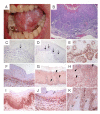The carcinogenic potential of tacrolimus ointment beyond immune suppression: a hypothesis creating case report
- PMID: 16405733
- PMCID: PMC1386691
- DOI: 10.1186/1471-2407-6-7
The carcinogenic potential of tacrolimus ointment beyond immune suppression: a hypothesis creating case report
Abstract
Background: Since tacrolimus ointment was approved by the U.S. Food and Drug Administration (FDA) as a promising treatment for atopic dermatitis, it has been approved in more than 30 additional countries, including numerous European Union member nations. Moreover, in the current clinical routine the use of this drug is no longer restricted to the approved indication, but has been extended to a wide variety of inflammatory skin diseases including some with the potential of malignant transformation. So far, the side-effects reported from the topical use of tacrolimus have been relatively minor (e.g. burning, pruritus, erythema). Recently, however, the FDA reviewed the safety of topical tacrolimus, which resulted in a warning that the use of calcineurin inhibitors may be associated with an increased risk of cancer.
Case presentation: Oral lichen planus (OLP) was diagnosed in a 56-year-old women in February 1999. After several ineffective local and systemic therapeutic measures an off-label treatment of this recalcitrant condition using Tacrolimus 0.1% ointment was initiated in May 2002. After a few weeks of treatment most of the lesions ameliorated, with the exception of the plaques on the sides of the tongue. Nevertheless, the patient became free of symptoms which, however, reoccurred once tacrolimus was weaned, as a consequence treatment was maintained. In April 2005, the plaques on the left side of the tongue appeared increasingly compact and a biopsy specimen confirmed the suspected diagnosis of an oral squamous cell carcinoma.
Conclusion: The suspected causal relationship between topical use of tacrolimus and the development of a squamous cell carcinoma prompted us to test the notion that the carcinogenicity of tacrolimus may go beyond mere immune suppression. To this end, tacrolimus has been shown to have an impact on cancer signalling pathways such as the MAPK and the p53 pathway. In the given case, we were able to demonstrate that these pathways had also been altered subsequent to tacrolimus therapy.
Figures


References
Publication types
MeSH terms
Substances
LinkOut - more resources
Full Text Sources
Other Literature Sources
Research Materials
Miscellaneous

